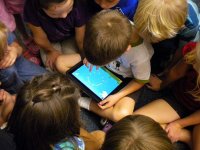Common Core in Action: Using Digital Storytelling Tools in the ELA Classroom
A storytelling app helps students use technology to produce and publish writing, collaborate with others, and hit the College and Career Readiness Anchor Standards for Writing.
When students come to school each morning, they have tons of stories -- stories to share with their friends as they unpack or move through the hallways, stories to share with the class during morning meetings, or stories to share with a teacher about something that made them happy or sad. In the classroom, writing can happen in many different ways, whether it's free writing in a notebook to gather ideas or publishing stories to share with the whole school.
The Common Core State Standards expect that children across the grades can write for three specific purposes:
- Opinion pieces that persuade a reader and make an argument
- Informative writing that explains an idea and relays information
- Narrative stories of real or imagined events.
As students move from one grade level to another, the complexity of these tasks will change greatly. The persuasive writing that takes place in a second grade classroom will look very different than the work that a seventh grader produces. From kindergarten through 12th grade, students are expected to share their writing through technology.
Making Their Voices Heard
The College and Career Readiness Anchor Standards for Writing give educators a snapshot of what all students need to be able to do as they prepare for life beyond the K-12 classroom. Each of these anchor standards corresponds to particular grade level standards that show the expectations for a specific grade in more detail. The writing standard that we're going to look at in this post asks students to publish their writing using technology:
There are a handful of terrific mobile apps to help students publish their writing using technology. These digital storytelling apps let students tell their stories using a variety of media, while keeping the craft elements for different writing tasks intact. They'll be able to publish their work for a larger audience and take on roles as they collaborate with their peers to create a final product.
Adobe Voice is a fantastic app for iPads that empowers students to tell stories straight from their tablet. Users can create a narrated slideshow that uses images, icons, and text in addition to the audio recordings. Students can also choose the theme and music they would like to include in their piece. Adobe Voice is a dynamic tool that can be used by children of all ages. With an intuitive, kid-friendly interface, tasks can be scaled up or down depending on the grade level of the students that you're working with. When students open up Adobe Voice, they'll have to login using a class or teacher account, or create their own. You can take children through the app or show them the Getting Started tutorial, which highlights important features.
Storytelling Guidelines
Just like any other time that you use technology with your students, you won't be handing them the device and sending them off to create. When it comes to publishing with technology, students should be at the end of the writing process. They've already drafted, revised, and edited their personal narrative, or their group has already come together to plan a presentation of their argument for an opinion piece of writing. I would encourage you to use a graphic organizer like a storyboard to have students plan what they want to appear on each page of their Adobe Voice creation. If students are working in pairs or a small group sharing one device, you'll want to make sure they have a plan for who will record the narration for each page.
Students can share their digital storytelling creations by sharing a link to their finished product. Schools that have a Twitter account or website might want to send out the links so that a wider audience can hear student stories. In classrooms that use student blogs or parent communication tools, it's simple to also share the link to Adobe Voice creations with viewers outside of your four walls. Using technology to publish is so much more than typing up a research report. Turn your students into digital storytellers with creation tools on mobile devices!
Have you had your students publish their writing using technology? What are your favorite digital storytelling apps?
